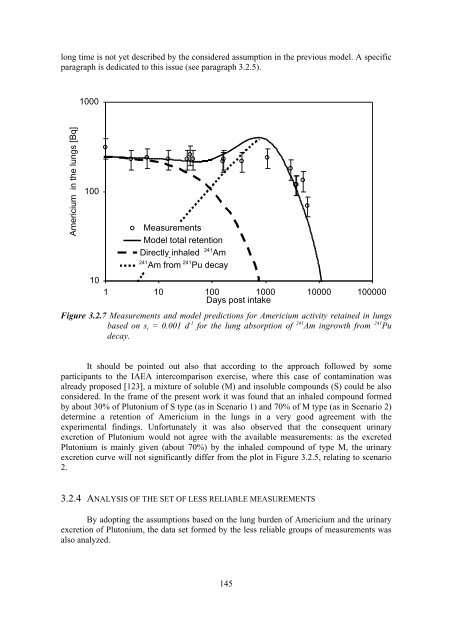Plutonium Biokinetics in Human Body A. Luciani - Kit-Bibliothek - FZK
Plutonium Biokinetics in Human Body A. Luciani - Kit-Bibliothek - FZK
Plutonium Biokinetics in Human Body A. Luciani - Kit-Bibliothek - FZK
You also want an ePaper? Increase the reach of your titles
YUMPU automatically turns print PDFs into web optimized ePapers that Google loves.
long time is not yet described by the considered assumption <strong>in</strong> the previous model. A specific<br />
paragraph is dedicated to this issue (see paragraph 3.2.5).<br />
Americium <strong>in</strong> the lungs [Bq]<br />
1000<br />
100<br />
10<br />
Measurements<br />
Model total retention<br />
Directly <strong>in</strong>haled 241Am<br />
241 241<br />
241Am Am from from Pu 241Pu decay decay<br />
241 Am<br />
1 10 100 1000 10000 100000<br />
Days post <strong>in</strong>take<br />
Figure 3.2.7 Measurements and model predictions for Americium activity reta<strong>in</strong>ed <strong>in</strong> lungs<br />
based on s t = 0.001 d -1 for the lung absorption of 241 Am <strong>in</strong>growth from 241 Pu<br />
decay.<br />
It should be po<strong>in</strong>ted out also that accord<strong>in</strong>g to the approach followed by some<br />
participants to the IAEA <strong>in</strong>tercomparison exercise, where this case of contam<strong>in</strong>ation was<br />
already proposed [123], a mixture of soluble (M) and <strong>in</strong>soluble compounds (S) could be also<br />
considered. In the frame of the present work it was found that an <strong>in</strong>haled compound formed<br />
by about 30% of <strong>Plutonium</strong> of S type (as <strong>in</strong> Scenario 1) and 70% of M type (as <strong>in</strong> Scenario 2)<br />
determ<strong>in</strong>e a retention of Americium <strong>in</strong> the lungs <strong>in</strong> a very good agreement with the<br />
experimental f<strong>in</strong>d<strong>in</strong>gs. Unfortunately it was also observed that the consequent ur<strong>in</strong>ary<br />
excretion of <strong>Plutonium</strong> would not agree with the available measurements: as the excreted<br />
<strong>Plutonium</strong> is ma<strong>in</strong>ly given (about 70%) by the <strong>in</strong>haled compound of type M, the ur<strong>in</strong>ary<br />
excretion curve will not significantly differ from the plot <strong>in</strong> Figure 3.2.5, relat<strong>in</strong>g to scenario<br />
2.<br />
3.2.4 ANALYSIS OF THE SET OF LESS RELIABLE MEASUREMENTS<br />
By adopt<strong>in</strong>g the assumptions based on the lung burden of Americium and the ur<strong>in</strong>ary<br />
excretion of <strong>Plutonium</strong>, the data set formed by the less reliable groups of measurements was<br />
also analyzed.<br />
145












![{A1[]Sp - Bibliothek](https://img.yumpu.com/21908054/1/184x260/a1sp-bibliothek.jpg?quality=85)




